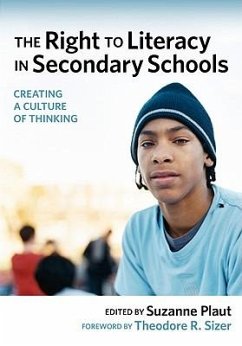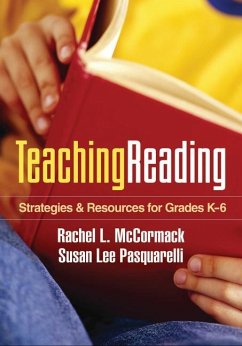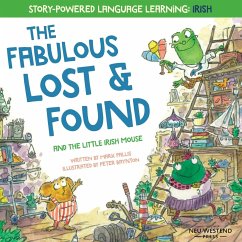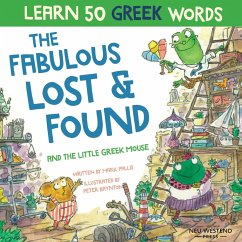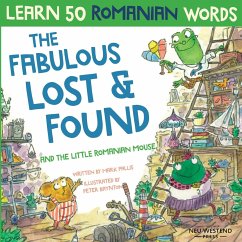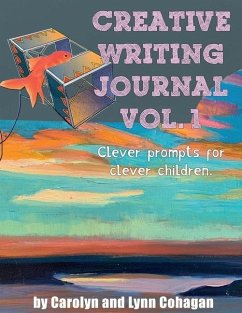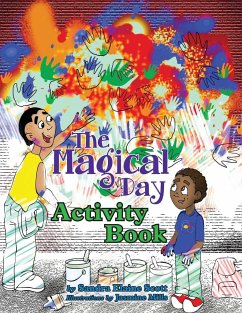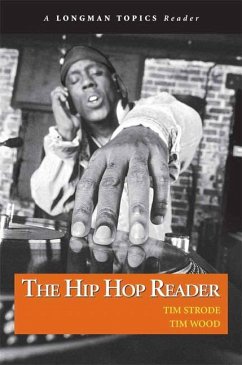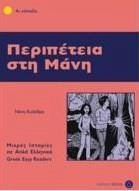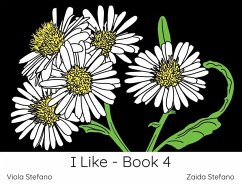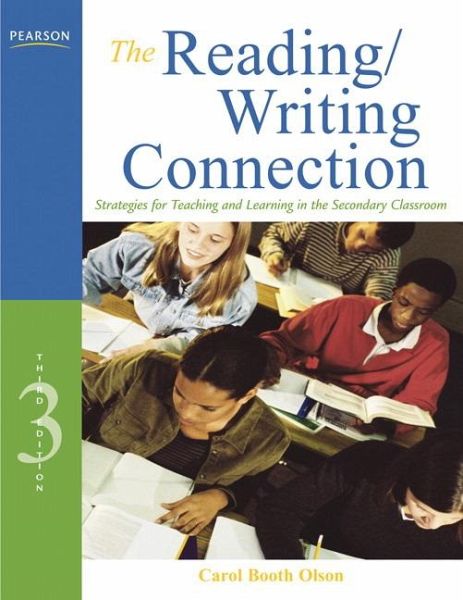
The Reading/Writing Connection
Strategies for Teaching and Learning in the Secondary Classroom
Versandkostenfrei!
Versandfertig in über 4 Wochen
79,99 €
inkl. MwSt.

PAYBACK Punkte
40 °P sammeln!
The Third Edition features an array of new and updated individual reading/writing strategies, activities and mini-lessons, and it scaffolds these strategies in extended demonstration lessons that teachers can implement in their middle and secondary English classrooms.
Well-respected author Carol Booth Olson extends far beyond most books intended for teachers of language arts by integrating reading and writing in creative, theory-based ways. Already a classic in its field, this book intends to explore and reinforce the reading/writing connection and thus help teachers make visible to their students what it is that experienced readers and writers do when they make meaning from and with texts. Lauded by students and professors as a clear and straight-forward book, this new edition includes plenty of material about teaching the writing process and responding to literature, and provides new and improved lessons and activities that help students learn specific strategies.
Product Description
The Third Edition features an array of new and updated individual reading/writing strategies, activities and mini-lessons, and it scaffolds these strategies in extended demonstration lessons that teachers can implement in their middle and secondary English classrooms.
Well-respected author Carol Booth Olson extends far beyond most books intended for teachers of language arts by integrating reading and writing in creative, theory-based ways. Already a classic in its field, this book intends to explore and reinforce the reading/writing connection and thus help teachers make visible to their students what it is that experienced readers and writers do when they make meaning from and with texts. Lauded by students and professors as a clear and straight-forward book, this new edition includes plenty of material about teaching the writing process and responding to literature, and provides new and improved lessons and activities that help students learn specific strategies.
New to this Edition:
New demonstration lessons that highlight students showing cognitive strategy use
More high school examples and references to high school texts throughout the book
A focus on 21st century literacies throughout the book with specific activities influenced by the Partnership for 21st Century Skills Framework and the 21st Century English Skills Map
Differentiation activities in several demonstration lessons for different student populations
Features + Benefits
· Practical demonstration lessons in almost every chapter model how to scaffold guided practice activities into coherent lesson sequences, paving the way for teachers to implement theoretically sound, teacher-tested lessons in the classroom.
· Provides student models at middle and high school levels in almost every chapter, illustrating actual student responses to reading and writing activities.
· "Learning Log Reflections" at the end of each chapter invite readers to take a step back and reflect upon what they have learned, providing teachers opportunities to engage in the same cognitive strategies that readers and writers use when they compose.
· Includes literary selections in almost every chapter, giving teachers easy access to the literature featured in the activities and demonstration lessons.
Backcover
Carol Booth Olson
The Reading/Writing Connection: Strategies for Teaching and Learning in the Secondary Classroom, 3/e
The Third Edition features an array of new and updated individual reading/writing strategies, activities and mini-lessons, and it scaffolds these strategies in extended demonstration lessons that teachers can implement in their middle and secondary English classrooms.
Well-respected author Carol Booth Olson extends far beyond most books intended for teachers of language arts by integrating reading and writing in creative, theory-based ways. Already a classic in its field, this book intends to explore and reinforce the reading/writing connection and thus help teachers make visible to their students what it is that experienced readers and writers do when they make meaning from and with texts. Lauded by students and professors as a clear and straight-forward book, this new edition includes plenty of material about teaching the writing process and responding to literature, and provides new and improved lessons and activities that help students learn specific strategies.
I will absolutely continue to adopt this text. It has useful demonstration lessons, clear explanation of the theory behind the practice, and creative aids and activities.
- Christine M. Mitchell, Southeastern Louisiana University, Hammond, Louisiana
This book has lots of good information and a variety of reading and writing activities that are engaging and useful.
- Maureen Siera, St. Martin's University, Associate Professor College of Education, Lacey Washington
Carol Booth Olson is Senior Lecturer in the Department of Education-University of California, Irvine, and the Director of the UCI/California/Writing Project. She received her Ph.D. in American Literature at UCLA in 1977 where she was honored as Outstanding Graduate Women of the Year. She has edited three books, including the best selling California Department of Education publication Practical Ideas for Teaching Writing as a Process and has written over 30 articles on teaching composition and literature. She has also served as a Senior Consultant to the Scott Foresman Literature and Integrated Studies Textbook series (1997). Dr. Olson has received two Excellences in teaching awards at UCLA.
Contents
Chapter 1 What is the Reading/Writing Connection?
Chapter 2 Introducing Students to the Cognitive Strategies in Their Mental Tool Kits
Chapter 3 Integrating Reading and Writing Instruction through Scaffolded Demonstration Lessons
Chapter 4 Connections Affect and Cognition
Chapter 5 A Multiple Intelligence Approach to Language Arts Instruction for Mainstream and English Language Development Classrooms
Chapter 6 Strategies for Interacting with a Text: Using Reading and Writing to Learn
Chapter 7 Teaching Literature: From Reading to Interpretation
Chapter 8 Reading, Thinking, and Writing about Multicultural Literature in Culturally Diverse Classrooms
Chapter 9 Teaching Writing: Helping Students Play the Whole Range
Chapter 10 Alternative Approaches to the Research Paper
Chapter 11 Sharing Our Responses to Texts as Readers and Writers and Revising Meaning
Chapter 12 Correctness Can Be Creative
Chapter 13 Assessing Students' Reading and Writing in the Classroom
Chapter 14 Cultivating Motivated, Independent Readers and Writers through Reading and Writing Workshop
Well-respected author Carol Booth Olson extends far beyond most books intended for teachers of language arts by integrating reading and writing in creative, theory-based ways. Already a classic in its field, this book intends to explore and reinforce the reading/writing connection and thus help teachers make visible to their students what it is that experienced readers and writers do when they make meaning from and with texts. Lauded by students and professors as a clear and straight-forward book, this new edition includes plenty of material about teaching the writing process and responding to literature, and provides new and improved lessons and activities that help students learn specific strategies.
Product Description
The Third Edition features an array of new and updated individual reading/writing strategies, activities and mini-lessons, and it scaffolds these strategies in extended demonstration lessons that teachers can implement in their middle and secondary English classrooms.
Well-respected author Carol Booth Olson extends far beyond most books intended for teachers of language arts by integrating reading and writing in creative, theory-based ways. Already a classic in its field, this book intends to explore and reinforce the reading/writing connection and thus help teachers make visible to their students what it is that experienced readers and writers do when they make meaning from and with texts. Lauded by students and professors as a clear and straight-forward book, this new edition includes plenty of material about teaching the writing process and responding to literature, and provides new and improved lessons and activities that help students learn specific strategies.
New to this Edition:
New demonstration lessons that highlight students showing cognitive strategy use
More high school examples and references to high school texts throughout the book
A focus on 21st century literacies throughout the book with specific activities influenced by the Partnership for 21st Century Skills Framework and the 21st Century English Skills Map
Differentiation activities in several demonstration lessons for different student populations
Features + Benefits
· Practical demonstration lessons in almost every chapter model how to scaffold guided practice activities into coherent lesson sequences, paving the way for teachers to implement theoretically sound, teacher-tested lessons in the classroom.
· Provides student models at middle and high school levels in almost every chapter, illustrating actual student responses to reading and writing activities.
· "Learning Log Reflections" at the end of each chapter invite readers to take a step back and reflect upon what they have learned, providing teachers opportunities to engage in the same cognitive strategies that readers and writers use when they compose.
· Includes literary selections in almost every chapter, giving teachers easy access to the literature featured in the activities and demonstration lessons.
Backcover
Carol Booth Olson
The Reading/Writing Connection: Strategies for Teaching and Learning in the Secondary Classroom, 3/e
The Third Edition features an array of new and updated individual reading/writing strategies, activities and mini-lessons, and it scaffolds these strategies in extended demonstration lessons that teachers can implement in their middle and secondary English classrooms.
Well-respected author Carol Booth Olson extends far beyond most books intended for teachers of language arts by integrating reading and writing in creative, theory-based ways. Already a classic in its field, this book intends to explore and reinforce the reading/writing connection and thus help teachers make visible to their students what it is that experienced readers and writers do when they make meaning from and with texts. Lauded by students and professors as a clear and straight-forward book, this new edition includes plenty of material about teaching the writing process and responding to literature, and provides new and improved lessons and activities that help students learn specific strategies.
I will absolutely continue to adopt this text. It has useful demonstration lessons, clear explanation of the theory behind the practice, and creative aids and activities.
- Christine M. Mitchell, Southeastern Louisiana University, Hammond, Louisiana
This book has lots of good information and a variety of reading and writing activities that are engaging and useful.
- Maureen Siera, St. Martin's University, Associate Professor College of Education, Lacey Washington
Carol Booth Olson is Senior Lecturer in the Department of Education-University of California, Irvine, and the Director of the UCI/California/Writing Project. She received her Ph.D. in American Literature at UCLA in 1977 where she was honored as Outstanding Graduate Women of the Year. She has edited three books, including the best selling California Department of Education publication Practical Ideas for Teaching Writing as a Process and has written over 30 articles on teaching composition and literature. She has also served as a Senior Consultant to the Scott Foresman Literature and Integrated Studies Textbook series (1997). Dr. Olson has received two Excellences in teaching awards at UCLA.
Contents
Chapter 1 What is the Reading/Writing Connection?
Chapter 2 Introducing Students to the Cognitive Strategies in Their Mental Tool Kits
Chapter 3 Integrating Reading and Writing Instruction through Scaffolded Demonstration Lessons
Chapter 4 Connections Affect and Cognition
Chapter 5 A Multiple Intelligence Approach to Language Arts Instruction for Mainstream and English Language Development Classrooms
Chapter 6 Strategies for Interacting with a Text: Using Reading and Writing to Learn
Chapter 7 Teaching Literature: From Reading to Interpretation
Chapter 8 Reading, Thinking, and Writing about Multicultural Literature in Culturally Diverse Classrooms
Chapter 9 Teaching Writing: Helping Students Play the Whole Range
Chapter 10 Alternative Approaches to the Research Paper
Chapter 11 Sharing Our Responses to Texts as Readers and Writers and Revising Meaning
Chapter 12 Correctness Can Be Creative
Chapter 13 Assessing Students' Reading and Writing in the Classroom
Chapter 14 Cultivating Motivated, Independent Readers and Writers through Reading and Writing Workshop
The Third Edition features an array of new and updated individual reading/writing strategies, activities and mini-lessons, and it scaffolds these strategies in extended demonstration lessons that teachers can implement in their middle and secondary English classrooms. Well-respected author Carol Booth Olson extends far beyond most books intended for teachers of language arts by integrating reading and writing in creative, theory-based ways. Already a classic in its field, this book intends to explore and reinforce the reading/writing connection and thus help teachers make visible to their students what it is that experienced readers and writers do when they make meaning from and with texts. Lauded by students and professors as a clear and straight-forward book, this new edition includes plenty of material about teaching the writing process and responding to literature, and provides new and improved lessons and activities that help students learn specific strategies. New to this Edition: * New demonstration lessons that highlight students showing cognitive strategy use * More high school examples and references to high school texts throughout the book * A focus on 21 st century literacies throughout the book with specific activities influenced by the Partnership for 21st Century Skills Framework and the 21st Century English Skills Map * Differentiation activities in several demonstration lessons for different student populations



